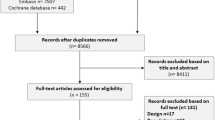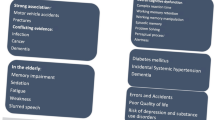Abstract
Purpose
Drugs prescribed for the treatment of insomnia can be either benzodiazepine hypnotics or the newer z-hypnotics, zopiclone and zolpidem. This paper explores possible explanations for the choice made.
Methods
Data from the Norwegian Prescription Database covering the entire population was studied for incident users of hypnotics. Possible predictors were age, gender, previous psychotropic or analgesic drug use and prescriber speciality.
Results
Of the 73,163 incident users of hypnotics, 3876 were prescribed benzodiazepine hypnotics in 2006. The strongest predictors for being prescribed benzodiazepines were previous use of anxiolytics [odds ratio (OR) 1.8, 95% confidence interval (CI) 1.7–2.0] and male gender (OR 1.5, 95% CI 1.4–1.6). Other significant predictors were antipsychotic or opioid drug use and the prescriber being a psychiatrist.
Conclusions
Z-hypnotics were commonly prescribed. Norwegian drug therapy recommendations also suggest a preference for z-hypnotics. The clear predominance of the shorter acting z-hypnotics may be due to the fact that only longer acting benzodiazepines are available in Norway. Reasons for prescribing benzodiazepines may be co-morbid psychiatric illness, such as anxiety, or a belief that benzodiazepine hypnotics are more effective than z-hypnotics.

Similar content being viewed by others
References
Hollister LE (1983) The pre-benzodiazepine era. J Psychoactive Drugs 15:9–13
Busto U, Lanctot KL, Isaac P, Adrian M (1989) Benzodiazepine use and abuse in Canada. Can Med Assoc J 141:917–921
Lader M (1991) History of benzodiazepine dependence. J Subst Abuse Tr 8:53–59
Miller LG, Woolverton S, Greenblatt DJ, Lopez F, Roy RB, Shader RI (1989) Chronic benzodiazepine administration. IV. Rapid development of tolerance and receptor downregulation associated with alprazolam administration. Biochem Pharmacol 38:3773–3777
Paterniti S, Dufouil C, Alperovitch A (2002) Long-term benzodiazepine use and cognitive decline in the elderly: the Epidemiology of Vascular Aging Study. J Clin Psychopharmacol 22:285–293
O’Hanlon JF, Vermeeren A, Uiterwijk MM, van Veggel LM, Swijgman HF (1995) Anxiolytics’ effects on the actual driving performance of patients and healthy volunteers in a standardized test. An integration of three studies. Neuropsychobiology 31:81–88
Hindmarch I, Fairweather DB (1994) Assessing the residual effects of hypnotics. Acta Psychiatr Belg 94:88–95
Goa KL, Heel RC (1986) Zopiclone. A review of its pharmacodynamic and pharmacokinetic properties and therapeutic efficacy as an hypnotic. Drugs 32:48–65
Girault C, Muir JF, Mihaltan F, Borderies P, De La Giclais B, Verdure A, Samson-Dollfus D (1996) Effects of repeated administration of zolpidem on sleep, diurnal and nocturnal respiratory function, vigilance, and physical performance in patients with COPD. Chest 110:1203–1211
Hajak G, Müller E, Wittchen HU, Pittrow D, Kirch W (2003) Abuse and dependence potential for the non-benzodiazepine hypnotics zolpidem and zopiclone: a review of case reports and epidemiological data. Addiction 98:1371–1378
Dolder C, Nelson M, McKinsey J (2007) Use of non-benzodiazepine hypnotics in the elderly: are all agents the same? CNS Drugs 21:389–405
NOMESCO (2004) Medicines consumption in Nordic countries 1999–2003. Nordic Medico Statistical Committee, Copenhagen
Rønning M (2001) Drug consumption in Norway 1996–2000. Norwegian Medicinal Depot, Oslo
The Norwegian Medicines Agency (2008) Available at: www.legemiddelverket.no. Accessed 9 May 2008
Walsh JK (2004) Drugs used to treat insomnia in 2002: Regulatory-based rather than evidence-based medicine. Sleep 27:1441–1442
Furu K (2001) Drug utilisation in a public health perspective: Establishing a national prescription register in Norway. Nor J Epidemiol 11:55–60
Furu K, Strøm H, Rønning M, Skurtveit S, Engeland A, Tverdal A (2005) The Norwegian Prescription Database (NorPD): new register for pharmacoepidemiological research covering a whole nation. Pharmacoepidemiol Drug Saf 14:S48
The Norwegian Prescription Database (2008) Available at: http://www.norpd.no. Accessed 9 May 2008
Griffiths RR, Weerts EM (1997) Benzodiazepine self-administration in humans and laboratory animals - implications for problems of long-term use and abuse. Psychopharmacology 134:1–37
Statistics Norway (2006) Available at: http://www.ssb.no. Accessed 9 May 2008
WHO (World Health Organization) Collaborating Centre for Drug Statistics Methodology (2005) Guidelines for ATC classification and DDD assignment. WHO, Oslo
Alonso J, Angermeyer MC, Bernert S, Bruffaerts R, Brugha TS, Bryson H, de Girolamo G, Graaf R, Demyttenaere K, Gasquet I, Haro JM, Katz SJ, Kessler RC, Kovess V, Lepine JP, Ormel J, Polidori G, Russo LJ, Vilagut G, Almansa J, Arbabzadeh-Bouchez S, Autonell J, Bernal M, Buist-Bouwman MA, Codony M, Domingo-Salvany A, Ferrer M, Joo SS, Martinez-Alonso M, Matschinger H, Mazzi F, Morgan Z, Morosini P, Palacin C, Romera B, Taub N, Vollebergh WA (2004) Psychotropic drug utilization in Europe: results from the European Study of the Epidemiology of Mental Disorders (ESEMeD) project. Acta Psychiatr Scand Suppl 420:55–64
Montplaisir J, Hawa R, Moller H, Morin C, Fortin M, Matte J, Reinish L, Shapiro CM (2003) Zopiclone and zaleplon vs benzodiazepines in the treatment of insomnia: Canadian consensus statement. Hum Psychopharmacol 18:29–38
National Institute of Clinical Excellence. Technology Appraisal Guidance 77 (2004) Guidance on the use of zaleplon, zolpidem and zopiclone for the short term management of insomnia. Available at: http://www.nice.org.uk. Accessed 9 May 2008
Terzano MG, Rossi M, Palomba V, Smerieri A, Parrino L (2003) New drugs for insomnia. Comparative tolerability of zopiclone, zolpidem and zaleplon. Drug Safety 26(4):261–282
Mahomed R, Paton C, Lee E (2002) Prescribing hypnotics in a mental health trust: what consultant psychiatrists say and what they do. Pharmaceutic J 268:657–659
Clark RE, Xie HG, Brunette MF (2004) Benzodiazepine prescription practices and substance abuse in persons with severe mental illness. J Clin Psychiatry 65:151–155
Miller NS (1995) Pharmacotherapy in alcoholism. J Addict Dis 14:23–46
Isacson D, Bingefors K, Wennberg M, Dahlström M (1993) Factors associated with high-quantity prescriptions of benzodiazepines in Sweden. Soc Sci Med 36:343–351
Wazana A (2008) Physicians and the pharmaceutical industry. Is a gift ever just a gift? JAMA 283:373–380
Beardon PH, McGilchrist MM, McKendrick AD, McDevitt DG, MacDonald TM (1993) Primary non-compliance with prescribed medication in primary care. Br Med J 307:846–848
Acknowledgments
The authors thank the Norwegian Foundation for Health and Rehabilitation as well as the Norwegian Council for Mental Health for financing the work of AMH.
Author information
Authors and Affiliations
Corresponding author
Rights and permissions
About this article
Cite this article
Hausken, A.M., Furu, K., Skurtveit, S. et al. Starting insomnia treatment: the use of benzodiazepines versus z-hypnotics. A prescription database study of predictors. Eur J Clin Pharmacol 65, 295–301 (2009). https://doi.org/10.1007/s00228-008-0565-8
Received:
Accepted:
Published:
Issue Date:
DOI: https://doi.org/10.1007/s00228-008-0565-8




